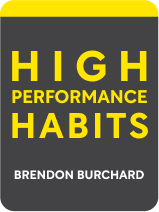

This article is an excerpt from the Shortform book guide to "High Performance Habits" by Brendon Burchard. Shortform has the world's best summaries and analyses of books you should be reading.
Like this article? Sign up for a free trial here .
Do you want to stay strong and healthy for life? What can you do to maintain good health physically, mentally, and emotionally?
In his book High Performance Habits, Brendon Burchard stresses the role of health in high performance. To be a high performer, you need to maintain all-around good health, including physical, mental, and emotional health.
Keep reading for Brendon Burchard’s techniques, tips, and principles that will help you maintain good health.
How to Maintain Good Health
If you want to maintain good health throughout your life, you need to give it you full attention and focus. While these techniques and tips are by no means exhaustive, the following three concepts will help you begin to develop healthier habits and develop your well-being: master transitions, find your joy, and treat your body better.
Master Transitions
People tend to carry tension without knowing it. This tension is often the result of an emotional response or stressful interaction. If you carry this tension into the rest of your day, you may make poor decisions or take your frustration out on an innocent person. For example, if you blew out a tire on your way to work, you may feel your shoulders and neck begin to tense and a headache begin to form. If you don’t take a moment to release this tension, you may take your frustration out on a colleague.
To prevent your frustration from impacting the rest of your day, learn to master transitions. In this context, a transition is the moment between two tasks or interactions. For example, if you’re responding to emails, then begin working on a project, you have a moment of transition between the two tasks.
If you feel frustrated or stressed, use these transitional moments to do the following:
- Close your eyes and breathe.
- Relax the areas of your body that are tense. Focus on your shoulders, neck, face, and jaw.
- Dictate the energy and perspective you want to bring into your next task or interaction.
- To take this to the next step, find a regular meditation or mindfulness system that resonates with you. Practice it regularly and use that time to let go of stress and focus on your goals.
Find Your Joy
The most powerful positive emotion is joy. If you can find joy within your work and personal life, other positive emotions will rise to the surface. While you can’t control your emotional responses, you can put yourself into a headspace that promotes joy over negative emotions. To do this, consider the following practices:
- Visualize positive feelings. Think about how you want to feel and visualize a scenario that generates positive feelings.
- Anticipate good outcomes. Rather than fearing for the worst, think about the best outcomes to decisions and projects.
- Imagine handling stressful situations in a positive way. This helps you respond positively when stress triggers an emotional response.
- Seek positivity. Actively look for opportunities to feel positive emotions such as gratefulness, curiosity, excitement, and joy.
- Spread positivity. When interacting with others, always look for ways to share positive emotions.
- Reflect on gratitude. Even in moments of frustration, think about all of the things that you’re grateful for.
In addition to the above practices, develop new emotional triggers that create positive emotions rather than negative ones. The following are mental triggers you can develop to keep yourself positive:
- Notification Triggers: Using your phone or a calendar app, set an alarm to go off multiple times a day. Label this alarm as a reminder to think about a positive emotion. This notification could read “Be Grateful,” “Find Joy,” or “Think Positively.” When you see this notification, take a second to generate positivity.
- Door Frame Triggers: When you walk through a door frame, take a moment to consider what energy you want to bring into the room, and what you want to get from the experience. For example, if you’re about to walk into a stressful meeting, you may tell yourself you want to bring a calm and supportive energy into the room and leave with feelings of dedication and focus.
- Waiting Triggers: When waiting in line, take a moment to check-in with how present you are on a scale from 1-10. If you’re below a 5, take a second to figure out what’s taking up space in your thoughts and try to bring yourself back to the moment.
- Touch Trigger: When you meet someone new, take a moment to interact with them in an appropriate, physical way. This could be a hug, a handshake, or a high-five. Physical interaction generates neurological responses that increase happiness.
- Gift Trigger: When something good happens, take a moment to recognize that positive interactions and outcomes are a gift. Use this gratitude to find ways that you can give back to those around you.
- Stress Trigger: When something causes you stress, take a moment to breathe, then think about what action you can invest in that will help you solve the problem that’s causing you stress. For example, if you just discovered a deadline has moved up by a few days, don’t allow yourself to fall into panic. Take a breath, then figure out the most effective way to handle the issue in front of you.
Treat Your Body Better
Taking care of your body will help you maintain good health not only physically, but also mentally and emotionally. Eating healthy, working out regularly, and sleeping well give you energy, create mental clarity, and release chemicals in your brain that help with emotional management.
Despite the significant benefits of taking care of your body, many people struggle to maintain good health because of excuses:
- “I don’t have the time.”
- “I have to make sacrifices.”
- “I’ve been doing fine with my current routine.”
- “I can’t focus on this right now. I’ll look at it in the future.”
- “I’m built differently from other people.”
Don’t buy into these excuses. Begin the journey of improving your physical well-being by developing the following habits:
- Eat healthier. Avoid overeating and cut out unhealthy foods. Find a long-term eating plan that you can stick to and hold yourself accountable.
- Create a regular workout schedule. This doesn’t have to be an intensive exercise regimen. Doing activities such as walking, cycling, or swimming at least three times a week will help you alleviate anxiety and increase your overall health.
- Sleep at least eight hours a night. Sleep gives your body a chance to rest and recover. Eight hours of sleep gives you more energy and focus during the day.
If you strive to maintain good health throughout your life, consider the following:
- Get a full health assessment. You can get one through your primary care physician. This assessment will tell you everything from your muscle-to-fat ratio to your cholesterol levels. Ask for the most comprehensive assessment they offer, including cancer screenings, brain scans, and X-rays. This will give you all of the information that you need to build your health and wellness plan.
- Talk to a nutritionist. While you may know the general rules of “eating healthy,” nutritionists will help you develop a more personalized and effective diet plan. They’ll make sure your diet is sustainable and can test you for potential food allergies.
- Get a personal trainer. A personal trainer will help you develop an effective and long-term exercise. They’ll also hold you accountable and make sure you’re pushing yourself safely.

———End of Preview———
Like what you just read? Read the rest of the world's best book summary and analysis of Brendon Burchard's "High Performance Habits" at Shortform .
Here's what you'll find in our full High Performance Habits summary :
- The 6 habits that high performers have
- How being a high performer is about more than one big achievement
- The 3 traps that can foil you, even if you're a high performer






